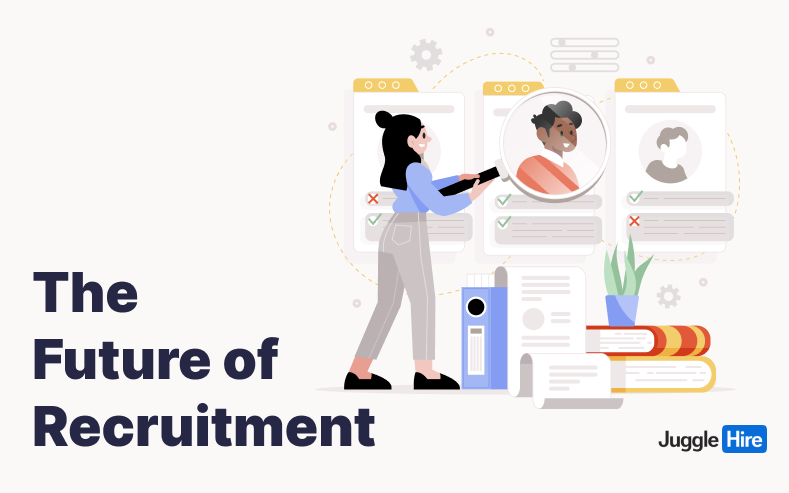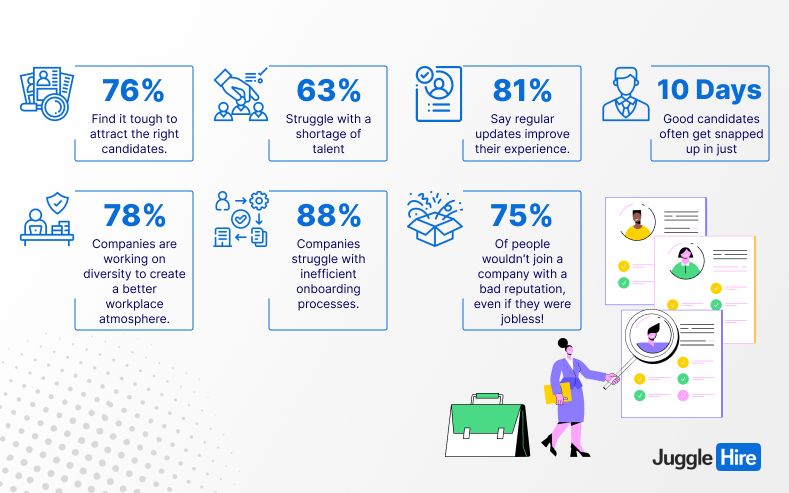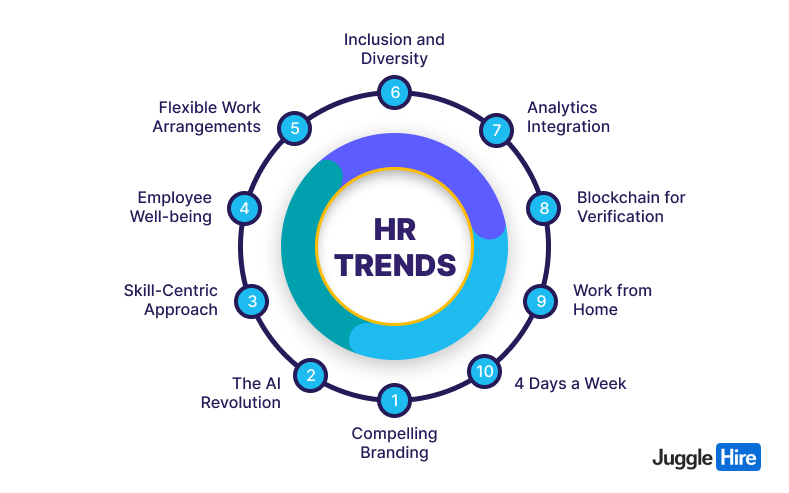Future of Recruiting: Top 10 Trends You Must Follow As a Recruiter

The recruitment industry has been static for quite some time. The COVID-19 pandemic has brought seismic shifts to the corporate line. Plus, we have seen a rise in transformative technologies like ChatGPT. This resulted in new challenges and opportunities for recruiters and HR leaders.
Now, we stand at the crossroads of uncertainty and innovation. We may see the integration of AI tools and strategies for talent attraction. Plus, hybrid workforces will probably increase in the year ahead. So, if you are in the recruiting line, you must be up-to-date with the latest trends and technologies.
On that note, we will point out the vital trends and groundbreaking technologies that will shape the future of recruiting. Together, let’s find out why there is a technological revolution about to happen in the recruiting industry.
What is The Current State of Recruitment?

The reach of the traditional recruitment method is limited. Job boards and local ads are not effective anymore. They indeed tap into a pool of candidates, but only for those who are actively seeking employment. They might miss out on exceptional talents by not actively job hunting. In the global job market, overlooking the best-fit candidates is a risk.
Companies should not rely on local sources for recruitment. This will result in a homogeneous candidate pool. In this case, similar backgrounds and experiences prevail. It lacks diversity concerning race, gender, age, and cultural background.
Most of the time, the costs associated with traditional recruitment methods are high. Advertising job openings, screening resumes, and conducting interviews consume time and financial resources.
Clearly, there are many deficiencies in the traditional recruitment process. Hence, recruiters can’t make informed, data-driven decisions. As a result, the current method of hiring can’t maintain a competitive edge anymore.
The good sign is many companies don’t rely on old, traditional hiring methods anymore. They are moving up and implementing smart practices to find the best candidates. This way, they are saving both money and time.
Big companies are already adopting advanced recruitment software (i.e., JuggleHire) and AI technologies. They assist them in finding job candidates, checking resumes, and setting up interviews. Many recruiters believe in the benefits of AI, with about 36% saying it would improve their work. On top of that, companies are adopting a virtual work culture.
Around 70% of companies say that at least half of their recruiting and onboarding processes are done virtually, with 1 in 10 reporting that they are entirely virtual.
Oracle NetSuite
As a result, recruiters don’t have to travel to various locations for interviews. This further reduces the overall expenses. So, small businesses or startups won’t face a financial challenge.
What Are the Challenges in Traditional Recruitment?

Recruitment is the heartbeat of businesses striving for success. However, the reliance on traditional methods comes with its own set of challenges. They impact the ability to attract top-tier talent.
I) Poor Way of Attracting the Right Candidates
Most hiring managers (76%) find it tough to attract the right candidates.
Linkedin
The struggle is real when you are sifting through a sea of underqualified applicants. Sometimes, it is not about the quantity but the quality. Therefore, you may want a smaller pool of highly qualified candidates. This can be the key to finding the perfect fit for the job.
II) Hard to Find Qualified Candidates
For recruiters, 63% struggle with a shortage of talent.
Linkedin
Elite candidates are like sought-after treasures. Standing out in their inbox requires extra finesse. When these candidates are juggling multiple job offers, your persuasion game must be strong. Convince them that your company is an undeniable choice amidst the competition.
Unfortunately, the picture is different from the traditional hiring process. Instead of convincing, recruiters often barrage them.
III) Slow Hiring Process
Good candidates often get snapped up in just 10 days.
The need for speed in hiring is real, but reality often drags its feet. The pressure to fill vacancies quickly clashes with the time it takes to find the right match. Long hiring processes can be a byproduct of a candidate shortage or internal delays. Balancing speed and precision is a perpetual challenge.
IV) Difficult to Build a Strong Employer Brand
Surprisingly, 75% of people wouldn’t join a company with a bad reputation, even if they were jobless!
Linkedin
A stellar employer brand is your golden ticket to attracting top talent. It is not just about job listings; it is a long-term approach. It includes tasks like ensuring a positive candidate experience and flaunting your culture on social media.
Building a strong employer brand demands collective effort, which is difficult with the traditional recruitment method. Step out of the routine, secure buy-in, and watch your brand shine.
V) Hard to Maintain a Good Candidate Experience
Candidates appreciate employers who keep them informed; 81% say regular updates improve their experience.
Linkedin
Hiring is not just a process; it is a preview of your company culture and how you value your people. Sometimes, candidates may not receive a decent experience during the hiring process. Yet, it echoes in their decisions. A bad experience can be a deal-breaker.
With the traditional approach, maintaining a good candidate experience is hard. So, you must change your hiring strategy. Remember, a positive candidate experience can enhance the employer’s brand.
VI) Difficulties in Recruiting Fairly
78% of companies are working on diversity to create a better workplace atmosphere.
Diversity matters, but biases often stand in the way. Beyond legal obligations, objective hiring is good business. It creates an inclusive workplace and showcases that you value meritocracy. However, the traditional recruitment process lacks diversity.
So, you must follow the latest trends in hiring to embrace diversity. It can ensure a positive impact during the hiring process. Therefore, potential candidates will see you as a fair and open-minded employer.
VII) Less Efficient Recruiting Process
88% of companies struggle with inefficient onboarding processes.
It is no small feat to coordinate the intricate dance of hiring teams, communication, and evaluation. Strained relationships between recruiters and hiring managers can add complexity. Plus, administrative tasks often steal precious time.
To Know More –
20 Common Recruitment Challenges (+ How to Solve Them)
The Future of Recruiting: 10 Best Trends and Technologies to Find the Best Candidates

Various trends and technologies are already shaping the recruitment process. It is only normal that the future of recruitment will undergo a significant transformation.
01. Compelling Branding:
In the competitive job market, powerful employer branding remains a key differentiator. Now, job seekers look for companies that value their qualifications. At the same time, they look for a satisfying work environment. They know that a reputed brand can offer all these.
Companies invest in several strategies to achieve a strong employer brand. They share employee testimonials and maintain an active social media presence. Similar strategies have become common practice.
02. The AI Revolution:
Artificial Intelligence (AI) is rapidly evolving in talent acquisition. This technology is handling a lot of tasks for the recruiters. For instance, AI can –
- Create smart talent platforms.
- Review resumes for specific skills.
- Give instant feedback and replies through chatbots.
- Find ideal candidates using natural language processing.
Just like the above tasks, AI is streamlining various aspects of the recruitment process. Technologies like ChatGPT have further expanded the features of AI. Now, employers can create interview questions, which takes less time than before. Plus, they can easily find innovative questions, which require intense brainstorming.
03. Skill-Centric Approach:
Companies are focusing on the skills of candidates more than ever. They continuously upskill and reskill employees. Therefore, employees undergo various training and development programs. Moreover, these programs can address skill gaps and retain top talent.
This shift towards specific, tangible skills is fostering a culture of continuous learning. In this case, technology is playing a crucial role in skill assessment. Now, comprehensive training programs often include tests, simulations, and project-based evaluations.
04. Employee Well-being:
The well-being of employees is a central focus in recruitment. Beyond competitive salaries, candidates seek workplaces that prioritize their physical and mental health. The COVID-19 pandemic accentuated this trend. In this case, the Great Resignation also played a vital role.
Now, companies adopt holistic approaches to provide better work-life balance. Their approaches also encompass mental health support and inclusive work cultures. Maintaining this trend is also important for their brand reputation.
Although medical and dental coverage remains highly sought-after among employees, many job seekers now desire additional support. About half of U.S. employees are seeking assistance from employers for different perks. These include retirement savings, work-life balance, and maximizing the value of their benefits.
05. Flexible Work Arrangements:
Remote work has become a mainstream employment model. This trend has become popular after the COVID-19 pandemic. It works well where the physical presence of employees is not mandatory. It saves companies and offices from huge rental costs. Plus, it influences job seekers’ preferences.
Companies with a remote work culture experience a lack of connection and support for remote team members. That is why they are implementing strategies to fill up the lack. This is the main reason why some companies are transitioning back to in-office work.

06. Inclusion and Diversity:
In earlier days, the traditional method was the only way to recruit. It didn’t bring much diversity and inclusion to the process, though they are the fundamental pillars of recruitment. However, things are changing now.
Nowadays, companies actively seek candidates with diverse perspectives. So, they invest in training to create more inclusive workplaces. Technology, including AI-driven tools, is being used to identify and eliminate biases. It is helping both in job descriptions and recruitment processes. Without a doubt, technology is promoting diversity and equity.
07. Analytics Integration:
The adoption of analytics in HR departments is a major trend. It has an impact on talent acquisition strategies. Analytical tools provide insights into various metrics, such as a source of hire, time to fill, and diversity-related metrics.
Almost all big and reputed companies use some kind of recruitment tool (like JuggleHire) or ATS (Application Tracking System). Most of the time, these tools come with analytic features. They provide real-time data about the hiring process. What’s more, these tools can provide analytical data from large companies to HR managers.
Now, predictive analytics is on the rise. Incorporating analytical tools is the first step toward initiating predictive analytics. It assists recruiters in forecasting trends and making informed decisions.
08. Blockchain for Verification:
Blockchain technology is gaining attention for verifying the authenticity of candidate credentials. Employers are exploring blockchain-based verification to enhance confidence in candidates’ qualifications. This technology is also used to analyze work histories.
Thanks to blockchain-based verification, companies eliminate the risk of hiring individuals with fraudulent claims on their resumes. With blockchain, recruiters make sure they are hiring the right person for a specific job. As a result, they won’t have to take frequent interviews for the same position.
09. Work from Home
At the very least, remote and in-person work hybrids are here to stay. Geographical restrictions on recruiting pools will be further loosened this year, as more than one-third of businesses indicate they are open to hiring remote employees around the globe.
Approximately 60% of candidates seek flexibility in terms of where and when they can work. Companies will stand out to job seekers if they offer remote work options. This includes standing workstations and noise-canceling headphones. Plus, they need collaboration tools and methods for learning and connecting virtually.
Those who complete a remote work certification course gain the knowledge and abilities necessary to operate remotely.
North Dakota State University
Companies like Ring Central are assembling fully virtual teams from the very beginning of their talent acquisition process. What’s more! The provider of collaboration platforms moved all of its internship offerings to a virtual project in 2020.
10. Four Days a Week
A four-day workweek means working 32 hours a week without losing pay or benefits. Different companies have different ways of doing it. Some have everyone work Monday through Thursday. Others let each person choose their extra day off or have a set day off for everyone, like Monday or Wednesday.
“The five-day week is a nineteenth-century construct that is not fit for purpose in the twenty-first century.”
Andrew Barnes (Author of 4 Day Week)
The main idea behind a four-day workweek is to get the same work done in less time. This gives people more time for their personal lives. They can spend time with family, pursue hobbies, or take care of things they need to do.
Companies could benefit from a four-day week too. It could mean more sales, fewer tired employees, and fewer people quitting. And because it’s about getting results, not just working hours, there’s no need to cut pay or benefits.
Don’t Miss Out –
Million-Dollar Tips for Hiring the Right Candidate in a Competitive Job Market
How Trends and Technologies Shape the Future of Recruiting

Trends and technologies are reshaping the recruitment process. They are making it more efficient and candidate-focused. Let’s explore how these advancements are influencing the way companies find and engage with potential hires:
a) AI’s Impact on Candidate Sourcing and Screening
Artificial Intelligence (AI) is changing the way candidate sourcing and screening. It utilizes intelligent algorithms and a process known as “semantic search”.
AI goes beyond mere keyword matching in resumes. It comprehends the context and intent behind words. Thus, recruiters get more accurate candidates based on the job description.
The features of AI have led to a remarkable 70% reduction in hiring time for some companies. Furthermore, AI assesses soft skills like communication and teamwork. AI can provide valuable insights by analyzing language use, tone, and speech patterns. These are often overlooked in traditional screening processes.
b) Chatbots Enhancing Candidate Experience
Chatbots are AI-powered tools. They play a vital role in improving the overall candidate experience, especially during the initial stages of recruitment.
Chatbots offer instant responses to candidate queries, provide updates on the application process, and even schedule interviews. They can analyze resumes, match candidates to suitable roles, and provide immediate feedback.
Websites with chatbots had significant advantages over those without:
- 95% more leads were generated
- 40% more applicants completed their applications
- 13% more clicked on job listings
On top of that, chatbots can automate repetitive tasks like sending reminders and updates. Chatbots are handy for shortening time-to-hire. Additionally, they ensure only the most qualified candidates progress to the next stage.
c) Predictive Analytics Streamlining Recruitment Decisions
Predictive analytics are powered by historical data analysis. Judging by these analytical data, recruiters can make informed decisions about candidate suitability for specific roles.
By identifying patterns in past recruitment data, predictive analytics predicts various outcomes. These can be candidate acceptance, job performance, and long-term commitment to the company. This predictive capability significantly enhances the quality of hires. It contributes to higher employee retention rates.
Moreover, predictive analytics measure growth projections and turnover rates. Therefore, they can aid in forecasting hiring needs. They enable proactive candidate sourcing and reduce time spent filling critical roles.
Future Challenges and Considerations in Recruitment
The world of recruitment is undergoing transformative shifts. Hence, understanding the upcoming challenges is essential for staying ahead of the game.

- Humanizing Recruitment with Generative AI: Generative AI (GAI) is a game-changer that allows recruiters to focus on the human aspects of hiring. Tools like ChatGPT intelligently generate content, streamlining tasks like drafting job descriptions and personalized messages. The optimistic sentiment around GAI is shared by hiring influencers. They emphasize the potential of GAI to save time. Therefore, GAI can enhance human connection in recruitment.
- Strategic Evolution in Recruiting: The aftermath of the pandemic and the challenges of the Great Reshuffle have catapulted recruiting into a more strategic role. A whopping 70% of talent acquisition professionals believe that their teams now rightfully claim a seat at the decision-making table.
- Reinforced Employer Branding: Despite a slowdown in hiring, the competition for talent remains fierce. Recruiting teams foresee a shift in power back to candidates and employees. Employer branding becomes a potent tool to attract and retain talent. It is not just about hiring; it is about creating an appealing workplace.
- Demand for Strategic Soft Skills: As recruiters evolve into strategic partners, a new set of soft skills comes to the forefront. Adaptability, problem-solving, and business acumen are among the top skills needed. Recruiters must adapt to the skills-first hiring trend. This way, they can evaluate and prioritize essential skills within their teams. So, the demand for soft skills can lead to a broader workforce.
- Collaboration with Learning and Development: The once-existing walls between recruiting and Learning and Development (L&D) are crumbling. More than half of Talent Acquisition professionals already collaborate closely with L&D, and this collaboration is expected to grow. Aligning learning programs with business goals becomes a joint focus. It forces recruiters to understand the necessary skills.
The Future of Hiring – Ending Note
In drawing the curtains on this exploration, it becomes clear that the future of recruiting is not a fixed destination. Rather, it is an ongoing expedition of refinement. Recruiters take advantage of emerging trends. Now, they can search through the uncharted territories of a rapidly evolving job market.
Agility, inclusivity, and mastery of skills reign supreme in the latest talent hiring process. Recruiters don’t have to deal with conventional norms anymore.
The future of recruitment promises to be dynamic, adaptive, and ever-forward. The trends and technologies will make it exciting and transformative.

It is the best time to make some plans for the future and it’s time
to be happy. I’ve read this post and if I could I desire to suggest you
few interesting things or advice. Perhaps you could write next articles referring to
this article. I wish to read even more things about it!
Thanks for your valuable comment Ramona, I will write articles on similar topics. So, please keep an eye out.
I’ve been browsing online more than 3 hours as of late, but
I by no means found any fascinating article like yours. It is
beautiful value enough for me. Personally, if all web owners and bloggers made good content as you probably did, the net might be much more helpful than ever before.
Thanks a lot. Glad to know my blog is helpful to you.
May I know which part of the blog you found most interesting?
This is a good tip especially to those new to the blogosphere.
Simple but very accurate information… Thank you
for sharing this one. A must read post!
Glad to know you have find this blog useful. Subscribe to our newsletter and never miss any informative blog like this one.
Let me know if I can help you with anything else, Thanks.
Excellent post but I was wanting to know if you could write a litte more on this
subject? I’d be very thankful if you could elaborate a little bit more.
Kudos!
Sure, we will publish more blogs on this subject. We always try to help our readers by crafting informative content. So, please subscribe to our newsletter for the upcoming blogs.
Also, let me know if I can help you with anything else.
Thanks for your query
Please suggest which part should I elaborate. Perhaps, I can tell you more on this by comment. You can also find out more by reading more our blogs. Stay up-to-date with our blogs by subscribing to our newsletter.
Your article helped me a lot, is there any more related content? Thanks!
Thanks, glad to know my articles helped you. Find more articles in our blog section (https://jugglehire.com/blog) or subscribe to our newsletter.
Thanks for sharing. I read many of your blog posts, cool, your blog is very good.
Thanks a lot. Please let me know if I can help you with anything and don’t forget to subscribe to our newsletter
Fabulous, what a website it is! This blog gives useful data to us, keep it up.
Thanks a lot Katja